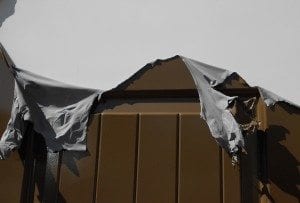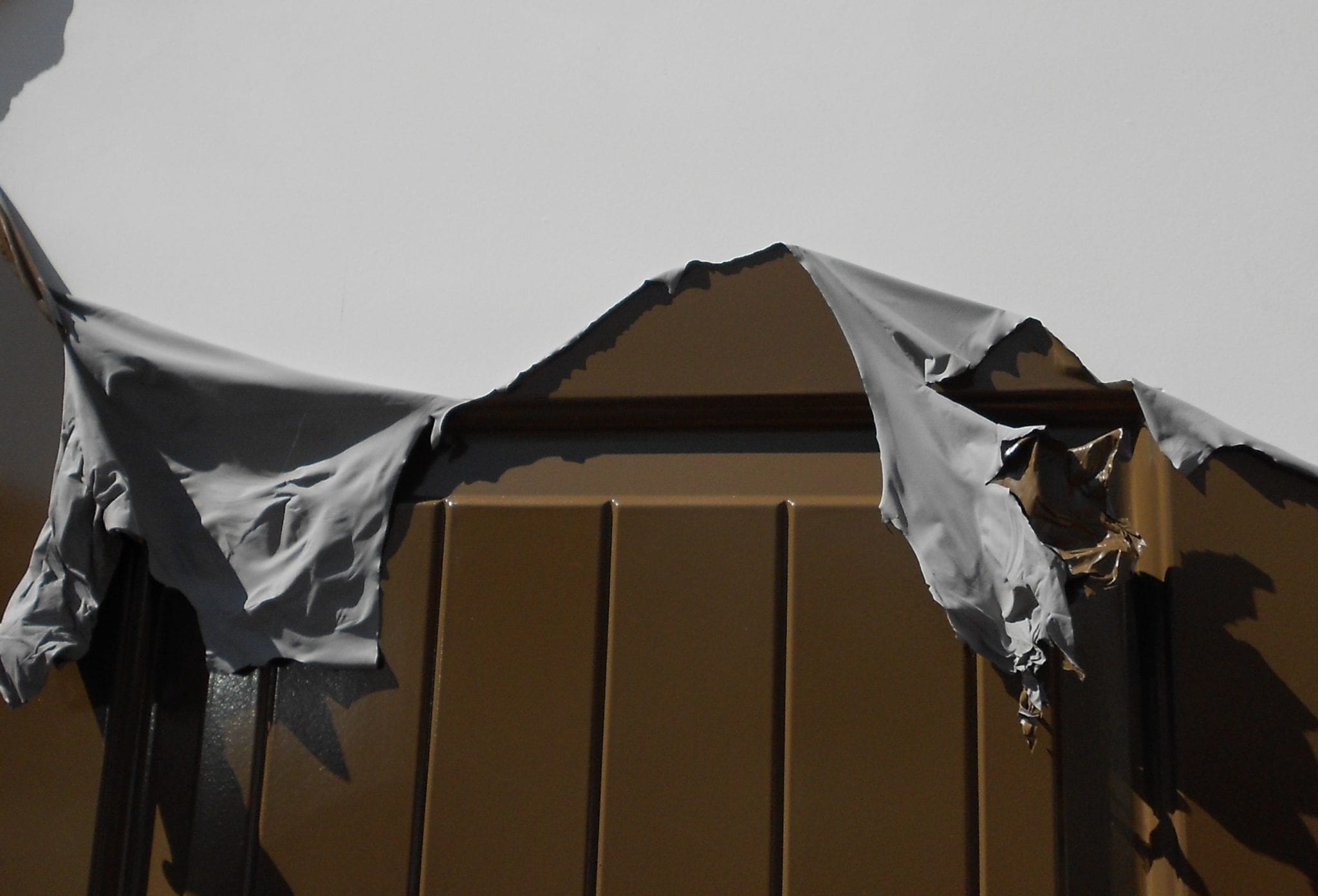Honestly, I don’t get the whole “no need to use a primer” thing.
Our company has done new construction homes for over 20 years and we have never skipped the primer! In fact, my husband Rob is so particular about the prep and prime stages that he will rarely try a new primer, but will happily demo a new paint! One thing he has always insisted on is re-priming factory painted doors.

On a recent job, circumstances happened that we skipped the re-prime on several doors. Big Mistake! We used Sherwin Williams Sologloss, a long time favorite, and sprayed the doors. The doors were left standing to dry for a day and the homeowner stacked them against each other, normally, this would not be a problem. When the doors were separated, there were a few spots that “stuck” and a few square inches peeled off. We thought we could sand it smooth and recoat, but the paint just peeled off in sheets. This has never happened on doors we re-primed.
Our Sherwin Williams rep had a sample tested, and sure enough, the primer had degraded and even though we wiped the doors, the “powder” of the failed primer caused the paint to not adhere, but to “skin”. There is not a lot of information on this that I could find as it relates to the degradation of shop primed surfaces. Most primers state to coat within 30 days. Using the right primer, whether it be on wood or drywall is important, as this from Bob Cusamano shows.
In doing some research on this, I came across this, from National Gypsum:
“It is recommended that the prepared surface be coated with a “drywall primer” prior to the application of final paint. See painting specification in this regard.” This is an important step that should not be forgotten before final decoration. “Drywall primer” replaced the term “primer/sealer” throughout the revised document. The application of high quality, high solids drywall primer minimizes most decorating problems.
I do believe the qualities in primer are different than paint, sure you can use the paint as a prime coat, but why would you use a more expensive paint rather than a product that was made for “foundation”. Primers are formulated with binders that facilitate adhesion, and they are designed to have “tooth” for the topcoat of paint to bond to. This is the concept of a multi-coat paint system. Sure, many paints will stick to wood or drywall, but they don’t seal the surfaces as well as primers that are intended to do that specifically. When using a primer, all the paint has to do is is build sheen and be pretty. The primer does that majority of the hard work at the surface.
I have compared primer in the past to the foundation makeup many of us women apply before the “finish” coat of blush, but I think Sherwin Williams explains it much better here:
Why is primer better than plain old paint?
Primer is specially formulated to make sure the top coat of paint adheres to the surface below, creating the best-looking, longest-lasting finish. Primers are engineered for aggressive filling and binding with underlying surfaces. If your client’s top coat of paint begins peeling or soaks unevenly into the surface because you didn’t specify using a primer, you’re back to square one – or worse.


Thanks for your timely article, Chris. I’m not a painter, I just consult for paint colors and make general product and process recommendations. I always specify “primer + 2 coats finish” – but also I suggest to the client that they consult with their painter for the best product, and even process, (in the brand being specified for color) to use for the project. Then, whatever the client decides to do with the painter doing the actual work, at least I am covered. Sometimes the client’s budget dictates that they go with a (ahem!) “shortcut” but I don’t want to be responsible for that.
Obviously I agree with you about the primer issue. For example, even on interiors, sometimes the old paint is, actually “old” and can benefit from the primer-sealer to ensure a better finish coat with 2 rather than 3 or more coats.
I never did understand why someone would risk having to do more than 2 topcoats (except in the case of some colors or situations) if they could get an excellent result with primer-plus-2 finish coats.
But, Anyone, please correct me if I am missing something since I do try to provide the best possible information.
Thanks Barbara. We do a lot of priming on repaints as well, I would much rather use a primer/topcoat than several topcoats as well. I feel the primer provides a better base, and is half the price of the topcoat. In many instances one topcoat over a primer (depending on the product) will be sufficient, but we usually do two for the best results.
Thanks Chris, it’s good to know I have been on “the right track” about that.
Thanks Chris for a great article. In our experience, about 80% of all coating failures can be directly attributed to unsatisfactory surface preparation that affects coating adhesion. Additionally, it is generally agreed that a cleaner surface will result in better coating performance.
I agree, the painting part is easy, it’s the devil in the prep details! Thanks for commenting!
I prefer to use an oil base primer as well and not just water base. Oil base has a strong odor but I still think it gives a better bond and will cure quicker than a water base primer.
Hi Chris
I enjoyed reading this article, here in the UK we have a smaller selection of self priming paints than you guys in the US. We use a couple from Bedec and Superdec made by Sadolin but almost always use a bridging primer on redecs due to these acrylics having no stain blocking properties, water stains in timber tend to bleed through the topcoats when using lighter colours. Do you find this is an issue on redecs? I know there are some water based paints that do have stain blocking properties when cured.
Having read through some of your articles I would say that the paints available to you guys are streets ahead of ours in the UK, although a couple of manufacturers (such as Mythic) have made their way across the pond but their products are at the top end of the market. ie. I couldn’t allow for Mythic on a large or commercial project as I know my price would not be competitive enough to secure the contract.
Hopefully one day the manufacturers here will crack the latex/acrylic paints and we can use them as a direct replacement for the traditional oils that we are all still using!
Thanks for commenting, because of VOC laws here in the states, the manufacturers have spent quite a bit in developing good alternatives to oil paint. I would have to defer to my colleague, Scott Burt of Topcoatreview for the definitive answers. On most redos, we have good results with water based primers and paints.
Wonderful article on primers, Chris!
I am a wallpaper removal professional and I would like to share some helpful comments about primer paints in regard to removal of wallcoverings. This is taken from my blog: http://totallyoffthewall.blogspot.com
What we often think of as our ‘wall’ when we look into wallpaper removal… is a bit of a misnomer. For, in truth, the wallcovering is actually adhered to the ‘paste’ (or other material) used and this ‘paste’ is actually adhered to an incredibly thin and quite vital layer of ‘paint’. There are many material properties of this thin layer of paint that affect the adherence of the paste and thus of the wallcovering. The paint may have many different properties such as gloss/matte surface finish; oil-based paint, latex-based paint, or acrylic-based paint; it can be a ‘primer’ that was designed for good adhesion to you wall surface; or it can be a ‘cheap’ grade of paint with a weak or even a completely ineffectual ‘bond’ to your wall surface (in which case the paint will come entirely off the wall – attached with the paste on the back of your wallcovering). In rare cases – because of a ‘missing’ paint layer, wallcovering may be adhered directly to the wall surface. Different wall surfaces (and, most importantly, their interactions with your paint layer) have a marked impact upon your wallpaper removal success chances… visit http://totallyoffthewall.com for more info. I do work nationally: 941 539-1954
I’m in the process of prepping a house to paint. It has a new addition but the rest of the house is so bad with “mud cracking” that I convinced the owner to re-side the house with new siding to match the addition. Siding is T1-11 and is treated.I’ve asked this elsewhere, but haven’t gotten an answer yet so I’ll try here. What are the feelings of you guys out there regarding primers? I’ll say straight up I hate Oil but I like to use whatever’s best. I’ve used Gripper and 1,2,3 in the past, but they are pretty thick, and therefore, I doubt they seep in much – more of a coating. On one job I used a Behr primer (Purple label, can’t remember the name) and it was a lot thinner, which seemed to soak more into the wood – not as much of a film coating and more like a stain. What do you think is better? Some of the guys I talk to like slow drying Oil (not Coverstain) because it seeps in. So I’m thinking, If a water based primer does the same thing, wouldn’t it be the best of both worlds?
Opinions welcomed.
Mike, I would recommend that you try SW Multi Purpose Acrylic primer. Its an interior/exterior rated product that is excellent in both, which is rare.
Thanks Scott.
I’m attending a S.W. Seminar on Tuesday and will see if they might comp me a Gal. to try. Still curious to know what people think of My theory about a latex primer that absorbs instead of using Oil?